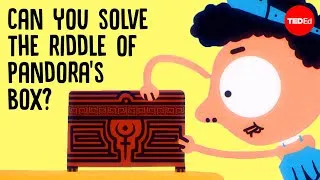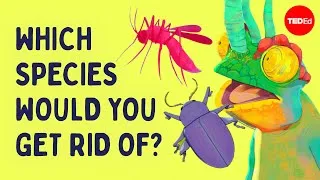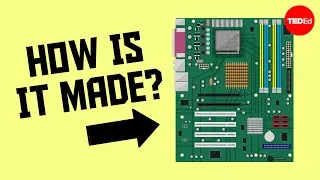請雙擊下方英文字幕播放視頻。
譯者: Lilian Chiu
審譯者: Helen Chang
00:06
You hear the gentle lap of waves,
0
6769
2939
你聽見海浪溫柔拍打的聲音,
00:09
the distant cawing of a seagull.
1
9708
2205
聽見遠方的海鷗叫。
00:11
But then an annoying whine
interrupts the peace,
2
11913
3907
但接著,惱人的聲音打斷了寧靜,
00:15
getting closer, and closer, and closer.
3
15820
3639
這聲音越來越近,越來越近。
00:19
Until...whack!
4
19459
2109
直到……狠狠一打!
00:21
You dispatch the offending mosquito,
and calm is restored.
5
21568
5049
你迅速了結進攻的蚊子,
再度恢復平靜。
00:26
How did you detect that noise from afar
and target its maker with such precision?
6
26617
5113
你是如何遠遠就偵測到那噪音的?
又如何準確找到噪音來源?
00:31
The ability to recognize sounds
and identify their location
7
31730
3736
你能辨識聲音並找出它們的所在
00:35
is possible thanks to the auditory system.
8
35466
3052
可能要感謝聽覺系統。
00:38
That’s comprised of two main parts:
the ear and the brain.
9
38518
4642
這系統主要由兩部分構成:
耳朵和大腦。
00:43
The ear’s task is to convert sound energy
into neural signals;
10
43160
4214
耳朵的工作是要把聲能
轉變成神經訊號;
00:47
the brain’s is to receive and process
the information those signals contain.
11
47374
4705
大腦的工作是要接收
和處理那些訊號所含的資訊。
00:52
To understand how that works,
12
52079
1819
為了要了解這系統如何運作,
00:53
we can follow a sound
on its journey into the ear.
13
53898
3649
我們跟聲音進入耳朵的旅程走一回。
00:57
The source of a sound creates vibrations
14
57547
2074
聲音的來源會創造出震動,
00:59
that travel as waves of pressure
through particles in air,
15
59621
3702
以壓力波的形式透過粒子在空中、
01:03
liquids,
16
63323
898
水中,
01:04
or solids.
17
64221
1504
或固體中傳遞。
01:05
But our inner ear, called the cochlea,
18
65725
2261
但我們的內耳,也就是耳蝸,
01:07
is actually filled
with saltwater-like fluids.
19
67986
3980
其實充滿了像鹽水一樣的液體。
01:11
So, the first problem to solve
is how to convert those sound waves,
20
71966
3886
所以,第一個要解決的問題
是如何轉換那些聲波,
01:15
wherever they’re coming from,
21
75852
1680
不論它們來自何處,
01:17
into waves in the fluid.
22
77532
2717
都要能轉為液體中的波。
01:20
The solution is the eardrum,
or tympanic membrane,
23
80249
3584
解決方案就是鼓膜,也就是耳膜,
01:23
and the tiny bones of the middle ear.
24
83833
3397
以及中耳的小骨頭。
01:27
Those convert the large movements
of the eardrum
25
87230
2940
它們將鼓膜的大震動轉換為壓力波,
01:30
into pressure waves
in the fluid of the cochlea.
26
90170
3758
傳入耳蝸的液體中。
01:33
When sound enters the ear canal,
27
93928
2058
當聲音進入耳道時,
01:35
it hits the eardrum and makes it vibrate
like the head of a drum.
28
95986
4027
它會撞擊到鼓膜,使之震動,
就像鼓的鼓皮一樣。
01:40
The vibrating eardrum jerks a bone
called the hammer,
29
100013
3926
震動的鼓膜會猛力推動
一塊骨頭,稱為錘骨,
01:43
which hits the anvil and
moves the third bone called the stapes.
30
103939
4738
它會撞擊到砧骨,
動到第三塊骨頭,叫做鐙骨。
01:48
Its motion pushes the fluid
within the long chambers of the cochlea.
31
108677
4365
它的活動就會推動
耳蝸長室當中的液體。
01:53
Once there,
32
113042
1347
一旦這些都完成了,
01:54
the sound vibrations have finally
been converted into vibrations of a fluid,
33
114389
4790
聲音震動就被轉換為液體的震動,
01:59
and they travel like a wave
from one end of the cochlea to the other.
34
119179
4025
之後它們就像波一般,
從耳蝸的一端傳導到另一端。
02:03
A surface called the basilar membrane
runs the length of the cochlea.
35
123204
4589
有片和耳蝸一樣長的表面,
叫做基底膜,
02:07
It’s lined with hair cells that have
specialized components
36
127793
4010
它的上面排滿了毛細胞,
毛細胞有專門的組成成分,
02:11
called stereocilia,
37
131803
1733
叫做纖毛,
02:13
which move with the vibrations of the
cochlear fluid and the basilar membrane.
38
133536
4400
纖毛會隨著耳蝸液體
和基底膜的震動而動。
02:17
This movement triggers a signal
that travels through the hair cell,
39
137936
4329
震動會觸發訊號,通過毛細胞傳輸,
02:22
into the auditory nerve,
40
142265
1889
傳到聽覺神經,
02:24
then onward to the brain,
which interprets it as a specific sound.
41
144154
4147
進而傳到大腦,
大腦將它轉譯為特定的聲音。
02:28
When a sound makes
the basilar membrane vibrate,
42
148301
3419
當一個聲音讓基底膜震動時,
02:31
not every hair cell moves -
43
151720
2649
並非所有的毛細胞都會跟著動,
02:34
only selected ones,
depending on the frequency of the sound.
44
154369
4875
只有被選中的毛細胞才會動,
根據聲音的頻率來選。
02:39
This comes down to some fine engineering.
45
159244
2471
這就涉及了非常精良的工程。
02:41
At one end,
the basilar membrane is stiff,
46
161715
3723
基底膜的一端是硬的,
02:45
vibrating only in response to short
wavelength, high-frequency sounds.
47
165438
5488
只有在遇到短波長、
高頻率的聲音時才會震動。
02:50
The other is more flexible,
48
170926
1819
另一端比較有彈性,
02:52
vibrating only in the presence of longer
wavelength, low-frequency sounds.
49
172745
4768
遇到較長的波長
和低頻率的聲音時才會震動。
02:57
So, the noises made by the seagull
and mosquito
50
177513
2948
所以,海鷗和蚊子造成的噪音,
03:00
vibrate different locations
on the basilar membrane,
51
180461
3076
會導致基底膜上
不同的位置產生震動,
03:03
like playing different keys on a piano.
52
183537
3214
就像按下鋼琴上不同的琴鍵一樣。
03:06
But that’s not all that’s going on.
53
186751
1912
但還不只如此而已。
03:08
The brain still has another
important task to fulfill:
54
188663
3976
大腦還有另一項重要的工作要完成:
03:12
identifying where a sound is coming from.
55
192639
2937
找出聲音是從何而來。
03:15
For that, it compares the sounds
coming into the two ears
56
195576
4037
為了這個目的,它會比較
來自兩隻耳朵的聲音,
03:19
to locate the source in space.
57
199613
2513
來判定聲音源頭在空間中的所在。
03:22
A sound from directly in front of you will
reach both your ears at the same time.
58
202126
4824
來自你正前方的聲音
會同時抵達你的兩耳。
03:26
You’ll also hear it at the same intensity
in each ear.
59
206950
3794
兩耳聽到的強度也會一樣。
03:30
However, a low-frequency sound
coming from one side
60
210744
3561
然而,來自單邊的低頻聲音,
03:34
will reach the near ear microseconds
before the far one.
61
214305
4542
抵達較近的耳朵和較遠的耳朵之間
會有幾微秒的時間差。
03:38
And high-frequency sounds will sound
more intense to the near ear
62
218847
3928
高頻的聲音,用近的耳朵
聽起來會比較強,
03:42
because they’re blocked
from the far ear by your head.
63
222775
3235
因為你的頭會擋住它們,
使之無法接觸較遠的耳朵。
03:46
These strands of information
reach special parts of the brainstem
64
226010
3755
這一股一股的資訊
會到達腦幹中的特殊部位,
03:49
that analyze time and
intensity differences between your ears.
65
229765
4359
這些部位會分析兩耳
聽到的時間差和強度差。
03:54
They send the results of their
analysis up to the auditory cortex.
66
234124
4623
它們會把分析結果送到聽覺皮質區。
03:58
Now, the brain has
all the information it needs:
67
238747
2986
現在,大腦有了所有需要的資訊:
04:01
the patterns of activity
that tell us what the sound is,
68
241733
2806
活動的模式說明聲音是什麼,
04:04
and information about
where it is in space.
69
244539
3894
還有關於在空間中所在位置的資訊。
04:08
Not everyone has normal hearing.
70
248433
2171
並不是每個人都有正常的聽覺。
04:10
Hearing loss is the third most common
chronic disease in the world.
71
250604
4445
聽力損失是世界上
排名第三的常見慢性疾病。
04:15
Exposure to loud noises
and some drugs can kill hair cells,
72
255049
4066
暴露在大聲的噪音或某些藥物中,
都可能殺死毛細胞,
04:19
preventing signals from traveling
from the ear to the brain.
73
259115
3897
讓訊號無法從耳朵傳到大腦。
04:23
Diseases like osteosclerosis freeze
the tiny bones in the ear
74
263012
4659
像骨質硬化這類的疾病,
會讓耳朵中的小骨頭僵固,
04:27
so they no longer vibrate.
75
267671
2170
它們就無法再震動。
04:29
And with tinnitus,
76
269841
1464
至於耳鳴,
04:31
the brain does strange things
77
271305
1659
大腦會做出很奇怪的事
04:32
to make us think there’s a sound
when there isn’t one.
78
272964
3708
在沒有聲音的時候,
讓我們認為有聲音存在。
04:36
But when it does work,
79
276672
1536
但在運作良好時,
04:38
our hearing is an incredible,
elegant system.
80
278208
2762
我們的聽覺是個很了不起、
很精緻的系統。
04:40
Our ears enclose a fine-tuned piece
of biological machinery
81
280970
3753
我們的耳朵內部
有很精確的生物機械裝置,
04:44
that converts the cacophony of vibrations
in the air around us
82
284723
3674
會把我們周邊空氣中的震動雜音轉換
04:48
into precisely tuned electrical impulses
83
288397
3140
成為精準的電脈衝,
04:51
that distinguish claps, taps,
sighs, and flies.
84
291537
4762
因此能區別出拍手、水龍頭滴水、
嘆氣,和蒼蠅的聲音。
New videos
關於本網站
本網站將向您介紹對學習英語有用的 YouTube 視頻。 您將看到來自世界各地的一流教師教授的英語課程。 雙擊每個視頻頁面上顯示的英文字幕,從那裡播放視頻。 字幕與視頻播放同步滾動。 如果您有任何意見或要求,請使用此聯繫表與我們聯繫。







